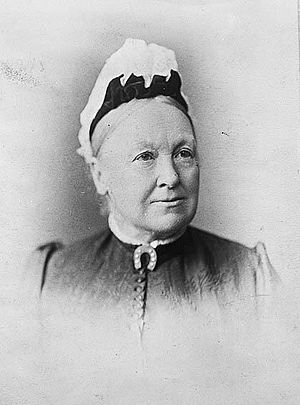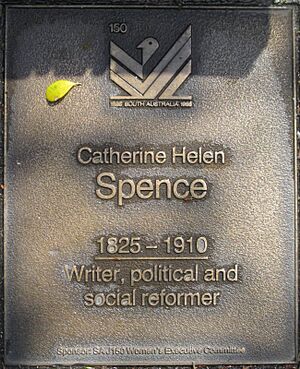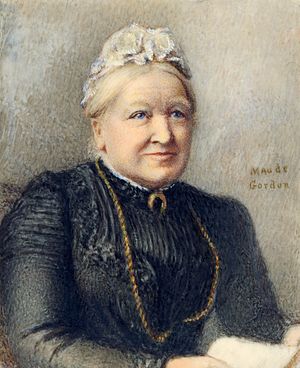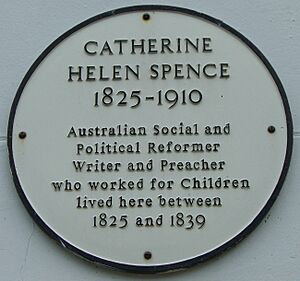Catherine Helen Spence facts for kids
Quick facts for kids
Catherine Helen Spence
|
|
|---|---|

Portrait of Catherine Helen Spence in the 1890s
|
|
| Born | 31 October 1825 Melrose, Scotland |
| Died | 3 April 1910 (aged 84) Norwood, South Australia |
| Occupation | Author, teacher, journalist and politician |
| Language | English-Scottish |
| Nationality | Australian |
| Notable works | Clara Morison: A Tale of South Australia During the Gold Fever |

Catherine Helen Spence (born 31 October 1825 – died 3 April 1910) was an amazing woman from Scotland who became a very important person in Australia. She was an author, teacher, and journalist. She also worked as a social worker and a minister of religion.
Catherine was a strong supporter of women's rights and fair voting systems. She is known for being Australia's first female political candidate in 1897. She tried to get elected to the Federal Convention in Adelaide, but she didn't win. People called her the "Greatest Australian Woman" and the "Grand Old Woman of Australia." She was even featured on the Australian five-dollar note for the Centenary of Federation of Australia.
Contents
Growing Up in Australia
Catherine Helen Spence was born in Melrose, Scotland in October 1825. She was the fifth of eight children. Her father, David Spence, was a banker and lawyer. Her mother was Helen Brodie. Catherine remembered having a very happy childhood.
She went to St. Mary's Convent School in Melrose from age four to thirteen. She really admired her teacher, Miss Phinn, who she thought was a great teacher.
In 1839, when Catherine was 14, her family faced money problems. They decided to move to South Australia. They arrived on her 14th birthday, October 31, 1839. The land was very dry, which was a big change from Scotland. Catherine felt very sad at first.
Her family tried farming for seven months before moving to Adelaide. Her father became the first Town Clerk of Adelaide. This was a very important job. However, the local government in Adelaide had problems in 1843. Her father lost his job and his health. He died three years later.
Catherine later wrote that she and her family grew to love South Australia. They felt it was a growing place where they could help create a better society. She learned a lot about how a country develops, like the importance of roads and ports. Catherine and her sisters opened a school and an orphanage. She never married, but she did turn down two marriage proposals.
Writing and Journalism
Catherine loved to write and wanted her ideas to be shared. When she was a teenager, she started writing short stories and poems. These were published in a newspaper called The South Australian.
Catherine and her sisters also worked as governesses. They taught children in some of Adelaide's important families. For many years, Catherine wrote for The Argus newspaper in Melbourne. She used her brother's name for her articles until the telegraph made communication faster.
Her first novel was called Clara Morison: A Tale of South Australia During the Gold Fever. She wrote it before she was 30. At first, it was rejected by publishers. But her friend, John Taylor, helped her find a publisher, and it came out in 1854. She was paid forty pounds for it. This was the first novel written in Australia by a woman. Around the same time, Catherine started working as a journalist for The Register newspaper. She didn't get her own name on the articles at first.
Her second novel, Tender and True, was published in 1856. It was very popular and was printed three times. However, she only received twenty pounds for it. She wrote many more novels, but some were not published until much later. These include Gathered In (published in 1977) and Hand fasted (published in 1984).
In 1888, she wrote A Week In the Future. This book described a perfect society she imagined a century later. It was one of the first books to imagine a future like this. Her last work, A Last Word, was unfortunately lost before it could be published.
Fighting for Fairer Votes
Catherine Spence was a strong supporter of women getting the right to vote. She also believed in a fair voting system called "proportional representation." This system makes sure that smaller groups of people are also represented in government. At one point, she thought this fair voting system was even more important than women's right to vote.
Catherine spoke at many events across Australia. She also gave speeches in Britain and the USA, including at the Chicago World's Fair in 1893. She was known as a powerful speaker for women's rights. When she returned to Australia, women in South Australia had won the right to vote in 1894. She didn't live to see women vote in her home country of Scotland, as that happened in 1918.
At her 80th birthday in 1905, Catherine gave a speech that still inspires people today. She said she was an "awakened woman" who felt responsible not just for her family, but for her country. She wanted women to use their wisdom to make the world a better place.
Catherine also traveled and lectured about "Effective Voting," which is now called Proportional Representation. She lived to see this system used in Tasmania.
Her Final Years
Catherine Helen Spence passed away at her home in Norwood, South Australia, on April 3, 1910. She was 84 years old. She was buried in the General Cemetery in Brighton, South Australia, next to her brother, J. B. Spence.
How She Is Remembered
On her 80th birthday in 1905, a public celebration was held for Catherine. Sir Samuel Way, a very important judge in South Australia, said she was "the most distinguished woman they had in Australia."
There are many memorials to Catherine Spence in Adelaide city centre, including:
- A bronze statue in Light Square.
- The Catherine Helen Spence building at the University of South Australia.
- The Spence wing of the State Library of South Australia.
- Catherine Helen Spence Street in the city.
- A plaque on the Jubilee 150 Walkway on North Terrace.
In her birthplace of Melrose, Scotland, there is also a plaque honoring her. It is now part of the Townhouse Hotel.
A painting of Catherine by Rose McPherson (who later became famous as Margaret Preston) is in the Art Gallery of South Australia. This painting was used for her image on the 2001 Australian five-dollar note.
In 1975, Australia Post honored her with a postage stamp that had her picture on it.
The Catherine Helen Spence Memorial Scholarship was created by the South Australian Government. It helps women aged 20-46 with their studies. You can find more information about it in a separate article.
Her picture also appeared on the special Centenary of Federation Australian five-dollar note in 2001. This note replaced the one with the Queen.
One of the schools in Aberfoyle Park, South Australia was named Spence in her honor. This school later joined with another to become Thiele Primary School.
The suburb of Spence in the ACT is sometimes thought to be named after Catherine Spence. However, it was actually named after a different person, William Guthrie Spence.
Her Books
Novels
- Clara Morison: A Tale of South Australia During the Gold Fever (1854)
- Tender and True: A Colonial Tale (1856)
- Mr. Hogarth's Will (1865) (first appeared as Uphill Work)
- The Author's Daughter (1868) (first appeared as Hugh Lindsay's Guest)
- Gathered In (serialised, possibly never a book)
- An Agnostic's Progress from the Known to the Unknown (1884)
- A Week in the Future (1889)
- Handfasted (1984) Penguin Originals ISBN: 0-14-007505-4
Non-fiction
- A Plea for Pure Democracy (1861) (a pamphlet praised by important thinkers)
- The laws we live under (1880) (for the South Australian Education Department)
- State children in Australia: A history of boarding out and its developments (1909) (about helping children in care)
See also
 In Spanish: Catherine Helen Spence para niños
In Spanish: Catherine Helen Spence para niños





